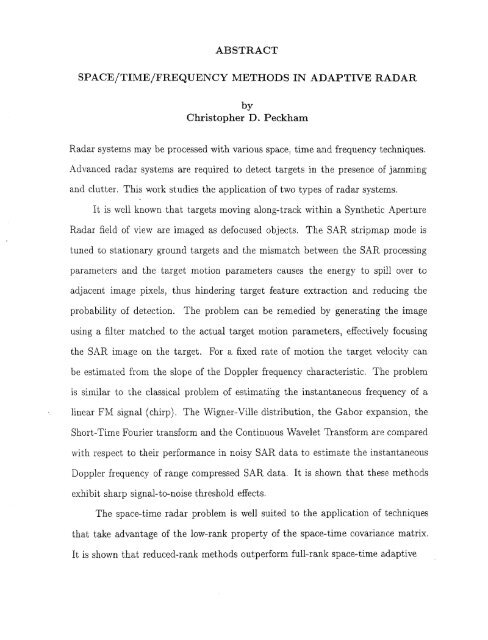Space/time/frequency methods in adaptive radar - New Jersey ...
Space/time/frequency methods in adaptive radar - New Jersey ...
Space/time/frequency methods in adaptive radar - New Jersey ...
You also want an ePaper? Increase the reach of your titles
YUMPU automatically turns print PDFs into web optimized ePapers that Google loves.
ABSTRACTSPACE/TIME/FREQUENCY METHODS IN ADAPTIVE RADARbyChristopher D. PeckhamRadar systems may be processed with various space, <strong>time</strong> and <strong>frequency</strong> techniques.Advanced <strong>radar</strong> systems are required to detect targets <strong>in</strong> the presence of jamm<strong>in</strong>gand clutter. This work studies the application of two types of <strong>radar</strong> systems.It is well known that targets mov<strong>in</strong>g along-track with<strong>in</strong> a Synthetic ApertureRadar field of view are imaged as defocused objects. The SAR stripmap mode istuned to stationary ground targets and the mismatch between the SAR process<strong>in</strong>gparameters and the target motion parameters causes the energy to spill over toadjacent image pixels, thus h<strong>in</strong>der<strong>in</strong>g target feature extraction and reduc<strong>in</strong>g theprobability of detection. The problem can be remedied by generat<strong>in</strong>g the imageus<strong>in</strong>g a filter matched to the actual target motion parameters, effectively focus<strong>in</strong>gthe SAR image on the target. For a fixed rate of motion the target velocity canbe estimated from the slope of the Doppler <strong>frequency</strong> characteristic. The problemis similar to the classical problem of estimat<strong>in</strong>g the <strong>in</strong>stantaneous <strong>frequency</strong> of al<strong>in</strong>ear FM signal (chirp). The Wigner-Ville distribution, the Gabor expansion, theShort-Time Fourier transform and the Cont<strong>in</strong>uous Wavelet Transform are comparedwith respect to their performance <strong>in</strong> noisy SAR data to estimate the <strong>in</strong>stantaneousDoppler <strong>frequency</strong> of range compressed SAR data. It is shown that these <strong>methods</strong>exhibit sharp signal-to-noise threshold effects.The space-<strong>time</strong> <strong>radar</strong> problem is well suited to the application of techniquesthat take advantage of the low-rank property of the space-<strong>time</strong> covariance matrix.It is shown that reduced-rank <strong>methods</strong> outperform full-rank space-<strong>time</strong> <strong>adaptive</strong>
















